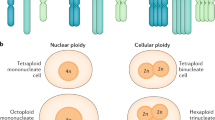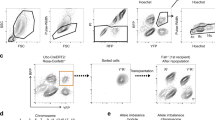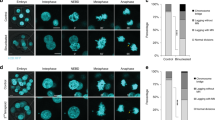Abstract
NATURAL alterations in the number of chromosome sets appear to be uncommon among the somatic tissues of animals. Somatic haploidy has been claimed to occur in the micromeres of sea-urchin embryos1, and in the tail mesenchyme of tadpoles2. The former case was quickly denied3, while the latter is also better interpreted as the pairing of homologous chromosomes. Polyploidy is well known in mammalian liver and in various tumours, but rarely in other tissues.
This is a preview of subscription content, access via your institution
Access options
Subscribe to this journal
Receive 51 print issues and online access
$199.00 per year
only $3.90 per issue
Buy this article
- Purchase on Springer Link
- Instant access to full article PDF
Prices may be subject to local taxes which are calculated during checkout
Similar content being viewed by others
References
Lindahl, P. E., Nature, 171, 437 (1953).
Green, E. U., Nature, 172, 766 (1953).
Makino, S., and Alfert, M., Experientia, 10, 489 (1954).
Wallace, H., J. Morph., 112, 261 (1963).
Wallace, H., Quart. J. Micro. Sci., 103, 25 (1962).
Elsdale, T. R., Fischberg, M., and Smith, S., Exp. Cell Res., 14, 642 (1958).
Kahn, J., Quart. J. Micro. Sci., 103, 407 (1962).
Author information
Authors and Affiliations
Rights and permissions
About this article
Cite this article
WALLACE, H. A Case of Somatic Polyploidy. Nature 199, 1115–1116 (1963). https://doi.org/10.1038/1991115b0
Issue Date:
DOI: https://doi.org/10.1038/1991115b0
This article is cited by
-
Alternative Model for Gene Amplification
Nature New Biology (1971)
Comments
By submitting a comment you agree to abide by our Terms and Community Guidelines. If you find something abusive or that does not comply with our terms or guidelines please flag it as inappropriate.



